
“The key to success in business is making sure you’re always available to your customers.” I’m sure you agree with this statement. Now picture this: A potential client calls your business, navigates through a confusing automated menu, presses button after button, and gets frustrated. Ultimately, they reach the voicemail and leave a message. Do such messages always get addressed? There’s no guarantee! Statistics reveal that “70% of callers abandon calls if they reach voicemail.” Often, businesses lose precious leads this way. But can you afford such dents in your customer satisfaction? Let’s talk about Direct Inward Dialing (DID) – A game changer in business communication.
Imagine a VIP customer needing immediate tech support gets connected with an IT expert within seconds using a direct phone line. No more frustrating menus, no more waiting in line, just a direct line to the person your customers need. That’s what DID is about. But I emphasize; don’t take my word for it. Let’s explore the world of DIDs, see how they work, and look at some real-life examples to understand the significance of their role in business communication.
What is Direct Inward Dialing (DID)?
DID is a short form of Direct Inward Dialing. It is a telephony feature using which you can assign individual phone numbers to your employees, teams, or departments. Thus, bypassing the need for going through automated menus, waiting in the call queues, or talking with a receptionist. You can think of DID as a shortcut straight to the intended person, every single time.
What is a DID Number?
A DID number is any business phone number that is configured to directly connect to a designated person within a company’s telephone network. DID numbers can exist as both virtual numbers and traditional telephone numbers.
An organization that employs a traditional landline PBX telephone system can get local phone numbers based on their location from their service provider. This means that these DID phone numbers are associated with physical phone lines.
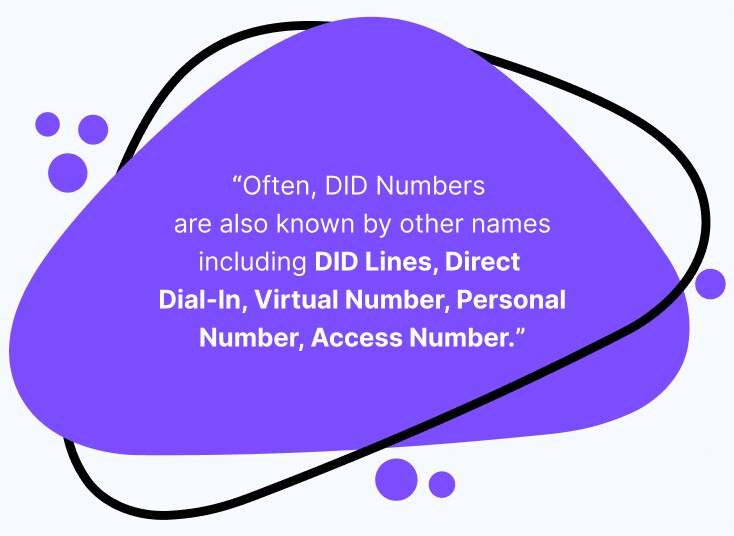
In the virtual sense, Direct Inward Dialing phone numbers operate over the internet and are often used in VoIP or cloud-based phone systems. Virtual DID numbers offer more flexibility, scalability, and advanced features which is why these are more popular in modern-day business setups. As a business or organization, you need to purchase DID numbers from a service provider. Once purchased, you can assign these numbers to individual extensions within your business. Now whenever an incoming call arrives on a DID number, the caller gets directly connected to the person associated with that number.
The choice between physical and virtual DID phone numbers is based on specific requirements and infrastructure of the business or organization.
Direct Inward Dialing Example
For instance, you placed an order for a product from ABC company. It’s been days and you’ve got no information about your order. So, you visit the company’s website and there you find separate numbers for separate departments. Say, one number is for ‘Customer Support’, another number is for ‘Sales’, and one more number is for ‘Billing’. Now, in your case, you dial the number of Customer Support to communicate your query. This means you directly connect with the associated department without calling the main head office of the ABC company. This saves you from a lot of hassle in terms of time and effort, right?
What Does a DID Number Look Like?
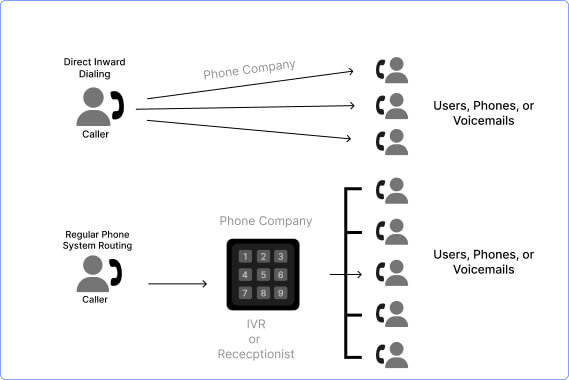
The above question is obvious. DID numbers are just like regular phone numbers formatted according to the standard phone number conventions of a particular country or area. What makes these numbers unique is the extension that follows the primary phone number. Here’s an example:
- DID Number: +1 555-7890
- Extension: ext. 1234
- Complete Number: +1 555-7890 ext. 1234
Here, the main phone number is followed by an extension. Callers can dial the complete number to reach the intended person directly.
What is Direct Inward Dialing Used For?
The primary purpose behind using DID numbers is to simplify and streamline external communication in business organizations. However, these days, DID numbers are also being used for improving internal business communication and collaboration. By assigning a unique DID number to every employee and department, direct lines of communication can be provided to colleagues and managers regardless of location. This is quite beneficial in the case of geographically dispersed teams.
Direct Inward Dialing Use Cases
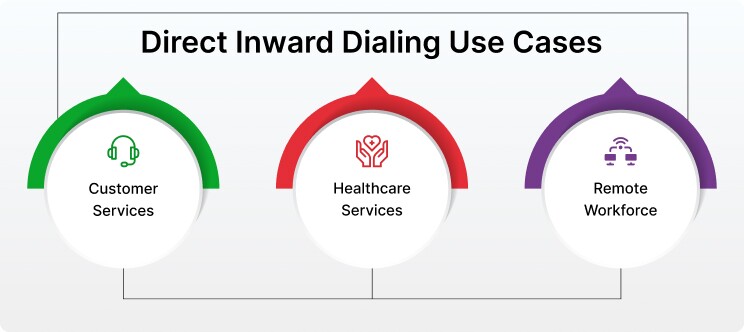
Customer Services
In customer service environments such as a call center, customers have different queries that are to be answered by different agents and departments. DID numbers are assigned to individual agents and different departments so that customers can reach the required agent or department most suitable for resolving their queries. For example, sales, tech support, billing, etc.
Healthcare Services
Businesses in the healthcare sector such as hospitals can assign DID numbers to individual doctors. This allows patients to reach out to their preferred doctor directly. Moreover, DID numbers can be assigned to the appointment scheduling department reducing wait times and improving patient satisfaction.
Remote Workforce
Today remote workers are increasingly dominating the global workforce. In such times, DID numbers offer a significant value. Separate DID numbers can be assigned to remote workers enabling them to maintain their professional presence as well as separating their work and personal lives.
How Does Direct Inward Dialing Work?
We know that when a caller dials a DID number, the call is directed to the associated person. But how does the call get routed to the correct person? To know this, we shall see how Direct Inward Dialing works. Mainly, there are 4 ways in which DID systems work:
- Cloud-based VoIP system
- SIP trunking with an onsite PBX system
- Traditional public-switched telephone network (PSTN)
- Fax
DID with Traditional PSTN
In the traditional landline phone system setup, DID service is leased from the service provider. Copper wires which are called Trunk Lines are installed and connected with the business’s or company’s PBX. The service provider then allocates DID numbers to the business/ company. When an inbound call is received from a DID number, the trunk line forwards it to the PBX system of the company. The system determines the dialed DID number and identifies an associated recipient. The PBX system then routes the call to the dialed extension number and connects the caller directly with the recipient.
It is important to note that businesses are required to dedicate separate physical copper lines to each user. Every copper line runs from outside the premises into the telephone room of the business’s office. From there, the wires connect to each phone jack at the user’s workstation. Because of this, DIDs with traditional phone systems limit a business to use only local DID numbers and only onsite phone system routing. Moreover, the cost of maintaining these physical phone lines can be very high.
DIDs with IP PBX and SIP Trunking
In the case of an onsite IP PBX, first, the VoIP provider receives the PSTN or VOIP transmission. Then it transmits the digital data to the business’s PBX system. Upon receiving this data, the PBX makes use of the Internet to direct the call to the correct user.
Compared to the traditional PSTN systems, IP PBX offers several advantages such as:
- Reduced infrastructure costs as there are no dedicated physical phone lines required.
- Better accessibility as IP PBX allows for expansion of global reach by getting local DID numbers of different locations.
- Availability of advanced features such as call forwarding, auto attendants, voicemail transcription, etc.,
DID with Cloud-Hosted VoIP
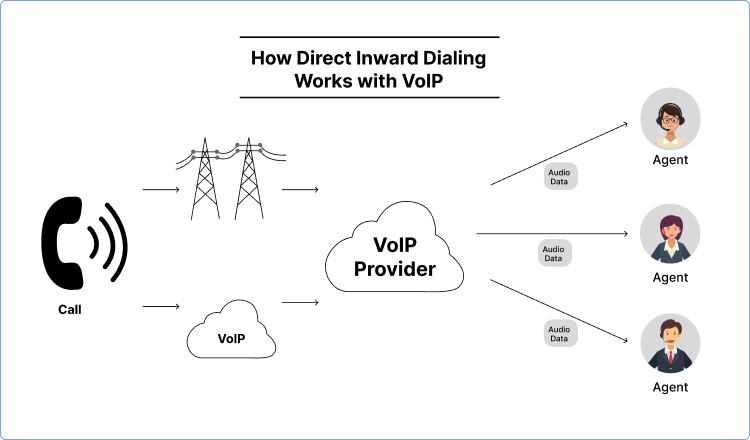
We all know that VoIP is the technology of today. This technology enables businesses to make and receive calls over the Internet. In the case of leveraging DID on VoIP, the virtual phone provider handles the SIP trunking i.e. creating the virtual links needed to receive all incoming calls, whether via PSTN or VoIP. The provider then virtually routes these calls to the appropriate DID number.
DID with VoIP offers some distinct benefits as mentioned below:
- It eliminates the need to connect the trunk lines to your PBX physically. This means you can set up as many trunk lines as you need.
- When it is about changing your provider then you can port your business phone numbers for a fraction of the cost.
DID with Fax
Besides phone calls, DID numbers are also used to route inbound faxes directly to specific users, devices, or phone numbers. A dedicated DID number can be assigned to a Fax machine. So, when someone sends a fax to this DID number, the system identifies the number and directs the incoming transmission to the associated fax machine. There is no need for manual intervention or a central reception point.
Why Do You Need Direct Inward Dialing?

If you are still thinking about getting DID numbers for your business, then I would like to ask you 2 simple questions.
- Do you experience a significant volume of incoming calls? Don’t only consider calls from your clients. Include your potential customers, partners, and every person who is associated with your business in one or the other way.
- Do you have different departments or teams in your company but they all receive incoming calls through one primary number?
Your answer to the above questions will help you determine whether you need DID numbers for your business or not. For any company that receives a good volume of incoming calls, DID can help streamline the overall communication flow. In relevance to the second question, having DID numbers for different departments in your business will reduce the unnecessary transfer of calls between teams and employees.
In essence, if the answer to the above questions is yes, then you certainly need DID numbers.
What are the Benefits of Using a Direct Inward Dialing System?
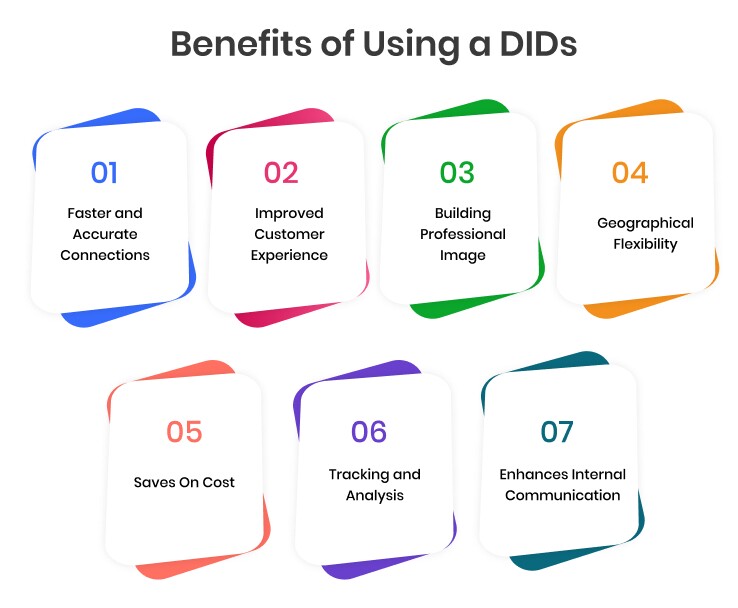
It won’t be wrong if I say that DID numbers are not just fancy phone lines but valuable assets to any organization. Let’s unfold the various benefits offered by DIDs:
-
Faster and Accurate Connections
Often callers get frustrated when they are stuck with vague self-service menu options. In such situations, callers either land to the wrong department or agent or simply hang up. But DIDs provide an effective solution to this problem by connecting the caller directly with the right department or agent, every time they call.
-
Improved Customer Experience
The more happy the customers, the more your business is going to thrive. DIDs simply slash wait times and boost customer satisfaction. How? With direct access to phone numbers of their preferred agents, customers don’t need to wait in call queues. They feel valued by the business, thus fostering customer experience and loyalty.
-
Building Professional Image
DID numbers for businesses allow small businesses to appear as large organizations. By purchasing multiple DID phone numbers and assigning them to different departments and employees, small businesses like startups can establish a professional image in front of their potential clients.
-
Geographical Flexibility
People prefer to call local phone numbers when they are looking for a product or service from a business. Using DIDs, businesses can establish a local presence in multiple markets around the globe. Suppose, a business operating in Miami can purchase local phone numbers in New York to establish its local presence in New York.
-
Saves On Cost
Eliminating the need for those expensive traditional phone lines, DIDs offer a cost-effective solution. Let’s imagine you are a startup with 15 employees. Rather than investing money on 10 separate physical phone lines, you can buy a bundle of DID phone numbers, say 20 phone numbers, at a much lower price. This helps save money for their crucial business units like sales, support, etc.
-
Tracking and Analysis
DIDs act as gold mines when it comes to tracking and analysis of customer data. Each DID number offers valuable information such as call volume, duration, and source. Tracking and analyzing this information can help unlock powerful business insights such as peak call times, departmental bottlenecks, the performance of the campaigns, etc.
-
Enhances Internal Communication
DIDs help in breaking down communication silos within a business organization. Firstly, DIDs enable direct peer-to-peer communication as employees can directly reach colleagues in other teams and departments. Secondly, DIDs also help in project-specific collaboration. By assigning a DID number to a project team, it acts as a central point of communication for all project-related matters. This improvement in communication and collaboration certainly streamlines workflows and boosts the efficiency of the employees.
How Do You Get A DID Number?
Now, I’m sure you are ready to get DID numbers for your business. Implementing DID numbers in your business includes a certain number of steps, but don’t worry, the overall process is easy and simple. Let’s take a look at the steps, one by one:
Decide Your Prefered Phone System Type
As I mentioned earlier in this post, DID numbers can be in both physical and virtual forms. So you need to decide whether you wish to go with a traditional landline PBX setup for your business or you want to implement a cloud-based phone system setup. The process of acquiring DID numbers for each phone system type is different. Our recommendation is to go for a cloud-based phone system and get virtual DID phone numbers, simply because it is easy and cost-effective.
Select a VoIP Service Provider
Now you need to search for a reliable VoIP service provider who offers DID numbers as well. there are many trusted names in the cloud telephony services market. You get as many DID numbers and a lot of advanced features as well from any reliable provider.
Figure out Your Requirements
Now, it is time to plan your DID requirements i.e. how many DID phone numbers do you need? Also, decide the location you want for your DID numbers. To figure this out, consider the number of employees, departments, and the location where your business operates.
Check Number Availability & Pricing
Once you are sure about your requirements, the next step is to contact your cloud telephony service provider. Share your DID requirements with them, and check the availability of numbers along with the pricing of plans. At any point in time, you may ask your provider to help you with selecting the appropriate Direct Inward Dialing numbers. They can provide you with a range of numbers including toll-free numbers, vanity numbers, local numbers, etc.
Configure Routing & Set Up Phone System
Now, for each DID number, you can configure call routing to define where the call will be directed when someone dials the number. Along with this, you need to set up your cloud phone system which is typically done through an online dashboard. Once done, you may test the setup by making and receiving a few calls. Check whether calls are routed to their correct destinations.
Use and Monitor
You can start using DID numbers for your business operations. Share DID numbers with respective employees, teams, and departments. You can include these numbers on your business’s marketing materials such as website, email, SMS, etc. so that customers can take note of these direct numbers. Make sure you monitor and manage the routing configurations continuously.
What is the Difference Between Direct Inward Dialing and Direct Outward Dialing?
Another term used often along with Direct Inward Dialing is DOD i.e. Direct Outward Dialing. This feature gives internal users i.e. employees of an organization, the ability to directly dial external phone numbers without needing to go through a central operator. In other words, we can say that employees can dial external phone numbers which could be clients’ directly from their desk phones.
While DID focuses on incoming calls, DOD pertains to outbound calls directly to external numbers. DID helps in improving accessibility for external callers and DOD enhances the efficiency of internal users. Direct Inward Dialing numbers are commonly used in customer service setups while DOD is relevant in companies where internal users make outbound calls.
What to Look for in a DID Provider?
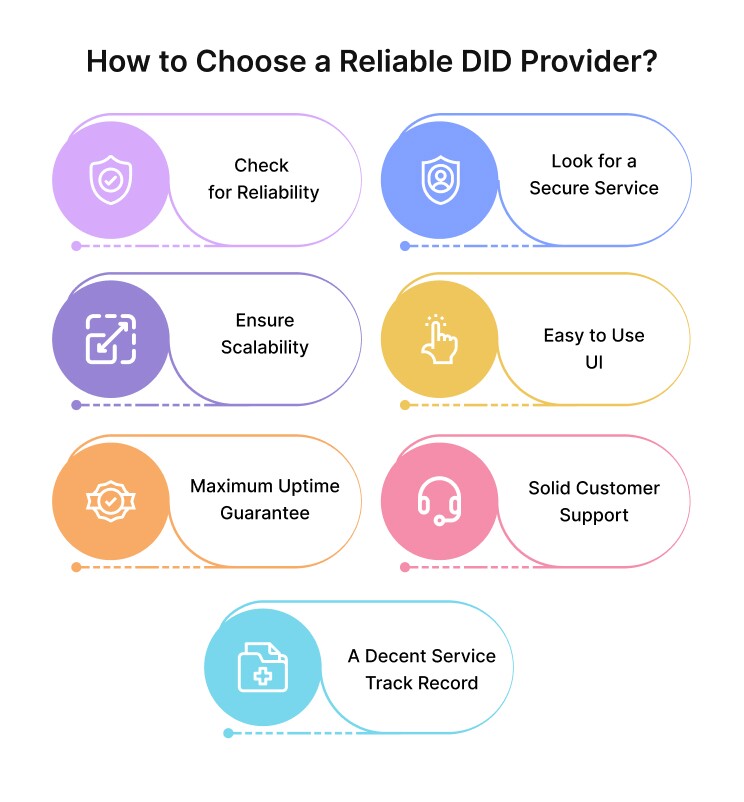
Your DID numbers lay the foundation of your business communication. It is therefore important that these numbers work correctly and offer high uptime. But how do you ensure that? Choosing the right DID provider is what you need to do. The below-mentioned questions can be your checklist to filter the best DID provider. Take a look:
-
Is the Provider Reliable?
The connections provided by the service provider must be fast and high in quality so that real-time communication happens without any interruptions.
-
Is the Service Secure?
Security and compliance are two important metrics that you cannot ignore. Check whether the service is proofed with the latest and most robust security measures. Also, make sure that the provider complies with the standard regulations.
-
How Many DIDs Can You Purchase?
Maybe initially, you purchased only a few DID numbers but as your business expands in the future you will need more. So make sure they can fulfill your future expansions easily.
-
What Features are Included?
Look for essential features like Voicemail Transcription, Call Recording, Call Forwarding, etc. You can also look for advanced features like analytics, IVR, and integration with other business tools.
-
Is the UI easy to Navigate?
Configuring and managing your DID numbers should always be a breeze. So make sure the User Interface or UI is easy to navigate.
-
What is the Uptime Guarantee?
These days service providers guarantee an uptime of as good as 99%. So ensure that you don’t look for anything less than that.
-
Is Customer Support Good Enough?
Prompt and reliable customer assistance is certainly required when dealing with business phone systems. Besides their 24/7 availability, make sure they offer support from various channels like email, SMS, live chat, etc.
-
What is the Provider’s Track Record?
Research about the provider’s reputation. Check for reviews by existing clients. Find out how long they have been in the industry. A well-established service provider is certainly a good choice to get started with.
Wrapping Up – Numbers Don’t Lie!
As per a study by Accenture, “91 percent of respondents are frustrated that they have to contact a company multiple times for the same reason”. In another study, it was found that “86% of the employees and executives cite a lack of ineffective communication for workplace failures”. Direct Inward Dialing is certainly the tool that provides effective solutions to these problems. Happy Direct Dialing!




























